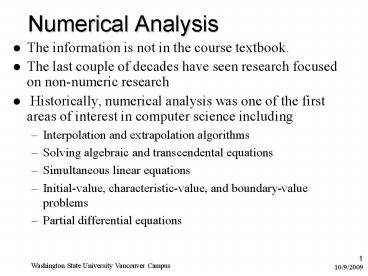Numerical Analysis PowerPoint PPT Presentation
1 / 15
Title: Numerical Analysis
1
Numerical Analysis
- The information is not in the course textbook.
- The last couple of decades have seen research
focused on non-numeric research - Historically, numerical analysis was one of the
first areas of interest in computer science
including - Interpolation and extrapolation algorithms
- Solving algebraic and transcendental equations
- Simultaneous linear equations
- Initial-value, characteristic-value, and
boundary-value problems - Partial differential equations
2
Numerical analysis
- Approximate computations are greatly affected by
errors - Numerical errors arise from different causes and
affect results in different ways - Round-off errors are due to the representation of
a number by a finite number of decimal digits.
(Clearly, an irrational number cannot be
precisely represented by a finite of digits) - Truncation errors are when a function f(x) is
represented by an infinite series but the series
is cut off after a finite number of terms. - Accumulated errors are errors that build up
during some sequence of operations. If the rate
of accumulation decreases, the error is bounded
and said to be stable. If it is unstable, it
renders the solution meaningless. - Absolute and relative errors need to be taken
into account.
3
Numerical Analysis
- Since we are dealing with approximations to the
real values, it is important to distinguish
between absolute error and relative error, of
representing a number ? by its approximation
?absolute error ? - ?,
? - ?relative error ----------
?
4
Numerical Analysis-finding roots
- Methods of finding roots of an equation given as
f(x) 0. We wish to determine x such that the
above equation is true. - Quadratic equation only for 2 roots
- Bisection method converges slowly
- Newton-Raphson converges rapidly but may
diverge.
5
Quadratic Equation
- This is well known from algebra
- ax2 bx c 0
- has roots at
6
Quadratic Equation
- In general, we cannot solve equations exactly and
need approximation algorithms to do so. - We cannot solve square roots exactly
- We do not have formulas for polynomials above
degree 4, but even the 3rd and 4th degree
equations are too cumbersome to be of value - In fact, Paolo Ruffini (1765-1822) in 1799
discovered that there can be no general formula
for their roots involving only the coefficients,
arithmetic operations, and taking square roots.
7
Bisection Method
- This method is based upon the observation that a
graph of a continuous function must intersect
with the x-axis between two points a and b at
least once if the functions values have opposite
signs at these two points. - See the next slide for an illustration
8
(No Transcript)
9
Bisection Method
- Since we cannot expect the algorithm to stumble
on the exact root, we need a criterion for
stopping the algorithm. - We can stop the algorithm after the interval
a,b bracketing some root x becomes so small
that we can guarantee that the absolute error of
approximating the root x by xn, the middle point
of the interval, is smaller than some small
pre-selected number, say ?gt0. Since xn is the
midpoint of a,b and x lies within this
interval, we have
10
- Hence, we can stop the algorithm as soon as
or, equivalently, when
11
Bisection Method
- The previous slide implies that the sequence of
approximations can be made as close to root x as
we with by choosing n large enough. In other
words, xn converges to x. - Note, however, that because any digital computer
represents extremely small values by zero, the
convergence assertion is true in theory, but not
necessarily in practice. - In fact, if we choose ? below a certain
machine-dependent threshold, the algorithm may
never stop! - Another potential complication is round-off
errors in evaluating the function in question.
Therefore, in practice, we usually limit the
bisection algorithm to a certain maximum number
of iterations.
12
Newton-Raphson
- This is one of the most important general
algorithms for solving equations. The general
analytical formula looks like
13
(No Transcript)
14
(No Transcript)
15
Newton-Raphson
- In most cases, Newtons algorithm guarantees
convergence of the sequence if an initial
approximation is close enough to the root.
However, as shown on the previous slide, it may
not converge for certain situations. - Newtons method generally converges much faster
than bisection. - Note that Newtons method requires an evaluation
of the function and the derivative of the
function whereas bisection requires only an
evaluation of the function. - A possible criterion for stopping Newtons
algorithm is simply when two successive guesses
are lt ? apart, or when xn xn-1 lt ?

